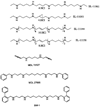Polyamine metabolism in a member of the phylum Microspora (Encephalitozoon cuniculi): effects of polyamine analogues
- PMID: 15133083
- PMCID: PMC3109667
- DOI: 10.1099/mic.0.26889-0
Polyamine metabolism in a member of the phylum Microspora (Encephalitozoon cuniculi): effects of polyamine analogues
Abstract
The uptake, biosynthesis and catabolism of polyamines in the microsporidian parasite Encephalitozoon cuniculi are detailed with reference to the effects of oligoamine and arylamine analogues of polyamines. Enc. cuniculi, an intracellular parasite of mammalian cells, has both biosynthetic and catabolic enzymes of polyamine metabolism, as demonstrated in cell-free extracts of mature spores. The uptake of polyamines was measured in immature, pre-emergent spores isolated from host cells by Percoll gradient. Spermine was rapidly taken up and metabolized to spermidine and an unknown, possibly acetamidopropanal, by spermidine/spermine N(1)-acetyltransferase (SSAT) and polyamine oxidase (PAO). Most of the spermidine and the unknown product were found in the cell incubation medium, indicating they were released from the cell. bis(Ethyl) oligoamine analogues of polyamines, such as SL-11144 and SL-11158, as well as arylamine analogues [BW-1, a bis(phenylbenzyl) 3-7-3 analogue] blocked uptake and interconversion of spermine at micromolar levels and, in the case of BW-1, acted as substrate for PAO. The Enc. cuniculi PAO activity differed from that found in mammalian cells with respect to pH optimum, substrate specificity and sensitivity to known PAO inhibitors. SL-11158 inhibited SSAT activity with a mixed type of inhibition in which the analogue had a 70-fold higher affinity for the enzyme than the natural substrate, spermine. The interest in Enc. cuniculi polyamine metabolism and the biochemical effects of these polyamine analogues is warranted since they cure model infections of Enc. cuniculi in mice and are potential candidates for human clinical trials.
Figures


References
-
- Ariyanayagam MR, Fairlamb AH. Diamine auxotrophy may be a universal feature of Trypanosoma cruzi epimastigotes. Mol Biochem Parasitol. 1997;84:111–121. - PubMed
-
- Bacchi CJ, Yarlett N. Polyamine metabolism as chemotherapeutic target in protozoan parasites. Mini Rev Med Chem. 2002;2:553–563. - PubMed
-
- Bacchi CJ, Lane S, Weiss LM, Yarlett N, Takvorian P, Cali A, Wittner M. Polyamine synthesis and interconversion by the microsporidian Encephalitozoon cuniculi. J Eukaryot Microbiol. 2001;48:374–381. - PubMed
-
- Bernacki RJ, Oberman EJ, Seweryniak KE, Atwood A, Bergeron RJ, Porter CW. Preclinical antitumor efficacy of the polyamine analogue N1,N11-diethylnorspermine administered by multiple injection or continuous infusion. Clin Cancer Res. 1995;1:847–857. - PubMed
Publication types
MeSH terms
Substances
Grants and funding
LinkOut - more resources
Full Text Sources
Research Materials
Miscellaneous

